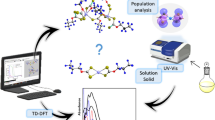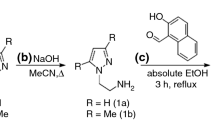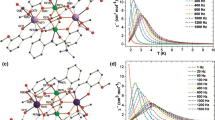Abstract
By means of quantum-chemical calculations using Density Functional Theory, Quantum Theory of Atoms in Molecules, and Natural Bond Orbitals, theoretical modeling of intermolecular interactions has been performed for eight nitrosyl iron complexes with aliphatic thiourea ligands, which was aimed at discovering the presence of the NO…NO intermolecular interactions and at studying the possibility of the NO…NO supramolecular synthon formation in their crystalline structure for explaining their unusual magnetic properties. Such interactions were shown to be either stacking or T-like interactions, depending on the relative position of nitrosyl ligands and energetically corresponding to Van der Waals bonds. Mainly LP(O), π (NO), and π*(NO) orbitals in various combinations participate in their formation, with π (FeN), π(FeО), and LP(N) orbitals hardly being participants. The involvement of the NO bond orbitals results in quenching the orbital moment of the NO groups. If NO groups are isolated from intermolecular interactions, they can preserve the unquenched orbital moment.






Similar content being viewed by others
References
Vanin AF (2017) Dinitrosyl iron complexes with thiol-containing ligands as a base for developing drugs with diverse therapeutic activities: physicochemical and biological substantiation. Biophysics 62:509–531. https://doi.org/10.1134/S0006350917040224
Fitzpatrick J, Kim E (2015) Synthetic modeling chemistry of iron–sulfur clusters in nitric oxide signaling. Acc. Chem. Res. 48:2453–2461. https://doi.org/10.1021/acs.accounts.5b00246
Lewandowska H (2014) Coordination chemistry of nitrosyls and its biochemical implications. Struct. Bond. 153:45–114. https://doi.org/10.1007/430_2013_102
Sanina NА, Aldoshin SМ (2011) Structure and properties of iron nitrosyl complexes with functionalized sulfur-containing ligands. Russ. Chem. Bull. 60:1223–1251. https://doi.org/10.1007/s11172-011-0192-x
Enemark JH, Feltham RR (1974) Principles of structure, bonding, and reactivity for metal nitrosyl complexes. Coord. Chem. Rev. 13:339–406. https://doi.org/10.1016/S0010-8545(00)80259-3
Chiang С-Y, Miller ML, Reibenspies JH, Darensbourg MY (2004) Bismercaptoethanediazacyclooctane as a N2S2 chelating agent and Cys-X-Cys mimic for Fe(NO) and Fe(NO)2. J. Am. Chem. Soc. 126:10867–10874. https://doi.org/10.1021/ja049627y
Tsai F-T, Chiou S-J, Tsai M-C, Tsai M-L, Huang H-W, Chiang M-H, Liaw W-F (2005) Dinitrosyl iron complexes (DNICs) [L2Fe(NO)2]− (L = thiolate): interconversion among {Fe(NO)2}9 DNICs, {Fe(NO)2}10 DNICs, and [2Fe-2S] clusters, and the critical role of the thiolate ligands in regulating NO release of DNICs. Inorg. Chem. 44:5872–5881. https://doi.org/10.1021/ic0505044
Hung M-C, Tsai M-C, Lee G-H, Liaw W-F (2006) Transformation and structural discrimination between the neutral {Fe(NO)2}10 dinitrosyliron complexes (DNICs) and the anionic/cationic {Fe(NO)2}9 DNICs. Inorg. Chem. 15:6041–6047. https://doi.org/10.1021/ic0605120
Harrop TC, Tonzetich ZJ, Reisner E, Lippard SJ (2008) Reactions of synthetic [2Fe-2S] and [4Fe-4S] clusters with nitric oxide and nitrosothiols. JACS 130:15602–15610. https://doi.org/10.1021/ja8054996
Vanin AF, Burbaev DS (2011) Electronic and spatial structures of water-soluble dinitrosyl iron complexes with thiol-containing ligands underlying their ability to act as nitric oxide and nitrosonium ion donors. Jornal of Biopysics. https://doi.org/10.1155/2011/878236
Schenk G, Pau MYM, Solomon EI (2004) Comparison between the geometric and electronic structures and reactivities of [FeNO]7 and [FeO2]8 complexes: a density functional theory study. JACS. 126:505–515. https://doi.org/10.1021/ja036715u
Shestakov AF, Shul'ga YM, Emel'yanova NS, Sanina NА, Aldoshin SМ (2007) Molecular and electronic structure and IR spectra of mononuclear dinitrosyl iron complex Fe(SC2H3N3)(SC2H2N3)(NO)2: a theoretical study. Russ. Chem. Bull. 56:1289–1297. https://doi.org/10.1007/s11172-007-0197-7
Shestakov AF, Shul'ga YM, Emel'yanova NS, Sanina NА, Aldoshin SМ (2006) Experimental and theoretical studies of the structure and IR spectra of neutral diamagnetic binuclear iron nitrosyl complexes Fe2(μ-SC6−n H5−n Nn)2(NO)4 (n = 0, 1, 2) Russ. Chem. Bull. 55:2133–2142. https://doi.org/10.1007/s11172-006-0564-9
Shestakov AF, Shul'ga YM, Emel'yanova NS, Sanina NА, Roudneva TN, Aldoshin SM, Ikorskii VN, Ovcharenko VI (2009) Experimental and theoretical study of the arrangement, electronic structure and properties of neutral paramagnetic binuclear nitrosyl iron complexes with azaheterocyclic thyolyls having ‘S–C–N type’ coordination of bridging ligands. Inorg. Chim. Acta 362:2499–2504. https://doi.org/10.1016/j.ica.2008.11.009
Brothers SM, Darensbourg MY, Hall MB (2011) Modeling structures and vibrational frequencies for dinitrosyl iron complexes (DNICs) with density functional theory. Inorg. Chem. 50:8532–8540. https://doi.org/10.1021/ic201137t
Lu T-T, Lai S-H, Li Y-W, Hsu I-J, Jang L-Y, Lee J-F, Chen I-C, Liaw W-F (2011) Discrimination of mononuclear and dinuclear dinitrosyl iron complexes (DNICs) by S K-edge X-ray absorption spectroscopy: insight into the electronic structure and reactivity of DNICs. Inorg. Chem. 50:5396–5406. https://doi.org/10.1021/ic102108b
Sandala GM, Hopmann KH, Ghosh A, Noodleman LJ (2011) Calibration of DFT functionals for the prediction of Fe Mössbauer spectral parameters in iron-nitrosyl and iron-sulfur complexes: accurate geometries prove essential. J. Chem. Theory Comput. 7:3232–3247. https://doi.org/10.1021/ct200187d
Aldoshin SM, Fel'dman EB, Yurishchev MA (2014) Quantum entanglement and quantum discord in magnetoactive materials. Low Temp. Phys. 40:5–21. https://doi.org/10.1063/1.4862469
Lyssenko KA, Ananyev IV, Aldoshin SM, Sanina NA (2015) Features of chemical bonding within the Fe(NO)2 fragment for crystalline bis (thiosulfate) tetranitrosyl diiron tetramethylammonium salt as an example according to high-resolution X-ray diffraction data. Russ. Chem. Bull. 64:2351–2360. https://doi.org/10.1007/s11172-015-1163-4
Nelyubina YuV, Korlyukov AA, Fedyanin IV, Lyssenko KA (2013) Extremely long cu···O contact as a possible pathway for magnetic interactions in Na2Cu(CO3)2. Inorg. Chem., 5214355-14363. https://doi.org/10.1021/ic4024025
Clark T, Murray J, Politzer P (2018) A perspective on quantum mechanics and chemical concepts in describing noncovalent interactions. Phys. Chem. Chem. Phys. 20:30076–30082. https://doi.org/10.1039/c8cp06786d
Politzer P, Murray J, Clark T, Resnati G (2017) The σ-hole revisited. Phys Chem. Chem. Phys. 19:32166–32178. https://doi.org/10.1039/C7CP06793C
Sanina NA, Aldoshin SM, Shmatko NY, Korchagin DV, Shilov GV, Ovanesyan NS, Kulikov AV (2014) Mesomeric tautomerism of ligand is a novel pathway for synthesis of cationic dinitrosyl iron complexes: Х-ray structure and properties of nitrosyl complex with thiourea. Inorganic Chemistry Communication. 49:44–47. https://doi.org/10.1016/j.inoche.2014.09.016
Sanina NA, Aldoshin SM, Shmatko NY, Korchagin DV, Shilov GV, Knyazkina EV, Ovanesyan NS, Kulikov AV (2015) Nitrosyl iron complexes with enhanced NO donating ability: synthesis, structure and properties of a new type of salt with the DNIC cations [Fe(SC(NH2)2)2(NO)2]+. New J. Chem. 39:1022–1030. https://doi.org/10.1039/C4NJ01693A
Sanina NA, Shmatko NY, Korchagin DV, Shilov GV, Terent’ev AA, Stupina TS, Balakina AA, Komleva NV, Ovanesyan NS, Kulikov AV, Aldoshin SM (2016) A new member of cationic dinitrosyl iron complexes family with N-ethylthiourea as an effective NO donor agent against human HeLa and MCF-7 tumor cell lines. J. Coord. Chem. 69:812–825. https://doi.org/10.1080/00958972.2016.1142536
Shmatko NY, Korchagin DV, Shilov GV, Sanina NA, Aldoshin SM (2017) Molecular and crystal structure of a cationic dinitrosyl iron complex with 1,3-dimethylthiourea. J. Struct. Chem. 58:353–355. https://doi.org/10.1134/S0022476617020172
Shmatko NY, Korchagin DV, Shilov GV, Ovanesyan NS, Kulikov AV, Sanina NA, Aldoshin SM (2017) The cationic dinitrosyl iron complexes family with thiocarbamide derivatives: synthesis, structure and properties in the solid state. Polyhedron 137:72–80. https://doi.org/10.1016/jpoly201708006
Aldoshin SM, Morgunov RB, Palii AV, Shmatko NY, Sanina NA (2015) Study of magnetic behavior of salts of cationic dinitrosyl iron complexes with thiocarbamide and its derivatives. Appl. Magn. Reson. 46:1383–1393. https://doi.org/10.1007/s00723-015-0689-9
Frisch MJ, Trucks GW, Schlegel HB, Scuseria GE, Robb MA, Cheeseman JR, Scalmani G, Barone V, Mennucci B, Petersson GA, Nakatsuji H, Caricato M, Li X, Hratchian HP, Izmaylov AF, Bloino J, Zheng G, Sonnenberg JL, Hada M, Ehara M, Toyota K, Fukuda R, Hasegawa J, Ishida M, Nakajima T, Honda Y, Kitao O, Nakai H, Vreven T, Montgomery JA, Peralta Jr, JE, Ogliaro F, Bearpark M, Heyd JJ, Brothers E, Kudin KN, Staroverov VN, Keith T, Kobayashi R, Normand J, Raghavachari K, Rendell A, Burant JC, Iyengar SS, Tomasi J, Cossi M, Rega N, Millam JM, Klene M, Knox JE, Cross J B, Bakken V, Adamo C, Jaramillo J, Gomperts R, Stratmann RE, Yazyev O, Austin AJ, Cammi R, Pomelli C, Ochterski JW, Martin RL, Morokuma K, Zakrzewski VG, Voth GA, Salvador P, Dannenberg JJ, Dapprich S, Daniels AD, Farkas O, Foresman JB, Ortiz JV, Cioslowski J, Fox DJ (2013) Gaussian 09, Revision D01, Gaussian, Inc, Wallingford CT
Emel’yanova NS, Shmatko NY, Sanina NA, Aldoshin SM (2015) Quantum-chemical study of the Fe(NO)2 fragment in the cation of mononuclear nitrosyl iron complex [Fe(SC(NH2)2)2(NO)2]Сl·H2O. Computational and Theoretical Chemistry 1060:1–9. https://doi.org/10.1016/j.comptc.2015.02.004
AIMAll (Version 15.05.18), Keith TA, TK Gristmill Software, Overland Park KS, USA, (2015) (aim.tkgristmill.com)
Sizova OV, Sokolov AY, Skripnikov LV, Baranovski VI (2007) Quantum chemical study of the bond orders in the ruthenium, diruthenium and dirhodium nitrosyl complexes. Polyhedron. 26:4680–4690. https://doi.org/10.1016/j.poly.2007.04.008
Funding
The authors receive financial support from the Ministry of Science and Higher Education RF - state registration no. АААА-А19-119071890015-6.
Author information
Authors and Affiliations
Corresponding author
Additional information
Publisher’s note
Springer Nature remains neutral with regard to jurisdictional claims in published maps and institutional affiliations.
Supplementary information
ESM 1
(DOCX 798 kb)
Rights and permissions
About this article
Cite this article
Aldoshin, S.M., Bozhenko, K.V., Utenyshev, A.N. et al. Formation of supramolecular synthons in the crystalline structure of the dinitrosyl iron complexes with aliphatic thiourea ligands. J Mol Model 26, 330 (2020). https://doi.org/10.1007/s00894-020-04594-z
Received:
Accepted:
Published:
DOI: https://doi.org/10.1007/s00894-020-04594-z




